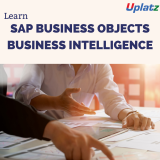SAP BusinessObjects (BO) Business Intelligence is a reporting tool offered by SAP. SAP BO offers intelligent solutions that can be made use of by people ranging from analysts and other people who work with information to CEOâ??s.
By the end of this training you will:
- Acquire the relevant knowledge required to clear the SAP certification exam.
- Understand the core concepts of SAPâ??s BO module.
- Be able to apply the knowledge learned to progress in your career as an associate level SAP BO consultant.
What is the target audience?
Everyone interested in SAP Business Objects
- Introduction:
- Understanding BusinessObjects Enterprise
- What is BusinessObjects Enterprise?
- Working with SAP BO Launchpad ( Infoview)
- SAP Business Objects Web Intelligence and BI Launch Pad 4.1
- SAP Business Objects Dashboards 4.1
- BI launch pad: Whatâ??s new in 4.1
- Restricting data returned by a query
- Enhancing the presentation of data in reports
- Formatting reports
- Calculating data with formulas and variables
- Using multiple data sources
- Analyzing data
- Managing and sharing Interactive Analysis documents
- Reporting from Other Data Sources
- Introducing Web Intelligence
- Accessing corporate information with Web Intelligence
- Understanding how universes allow you to query databases using everyday business terms.
- Managing documents in InfoView
- Viewing a Web Intelligence document in InfoView
- Setting Info View Preferences
- Creating Web Intelligence Documents with Queries
- Getting new data with Web Intelligence
- Creating a new Web Intelligence document
- Modifying a documentâ??s query
- Working with query properties
- Restricting Data Returned by a Query
- Modifying a query with a predefined query filter
- Applying a single-value query filter
- Using prompts to restrict data
- Using complex filters
- Displaying data in tables and charts
- Presenting data in free-standing cells
- Enhancing the Presentation of Reports
- Using breaks, calculations, sorts and report filters
- Ranking data to see top or bottom values
- Using alerters to highlight information
- Organizing a report into sections
- Copying data to other applications
- Alternative Query Techniques Using Combined Queries Using Sub-Queries
- Creating a Query based on another Query
- Character and Date String Functions Using the character string functions Concatenating different data types Using date functions
- Using If Logic
- Grouping data using If() logic
- Using If() to modify calculation behavior
- Advanced Reporting Features Formatting breaks
- Creating custom sorts
- Displaying document data in free-standing cells
- Alternative Query Techniques Defining Combined Query Types Using Combined Queries
- Using Sub-Queries
- Creating a Query on a Query
- Character and Date String Functions Understanding Character Strings
- Using Date Functions User-Defined Objects Creating User Objects
- Using a User Object in a Query
- Editing a User Object Deleting a User Object Storing a User Object Grouping Data
- Information Design Tool 4.0
- What is the Information Design Tool (IDT)
- Create a project
- Create a connection to a relational database (Single and Multiple databases)
- Create the data foundation with Single & Multiple databases
- Define the different types joins in a data foundation
- Create a business layer
- Create folders and objects
- Resolve Loops and Use alias
- Resolve Loops Use contexts
- Resolving the fan traps and Chasm traps problem
- Define data restrictions
- Work with LOVs
- Use Parameters restrict data
- Use @functions also Aggregate Awareness
- Create Derived Tables and Index Awareness
- Maintain universes
- Deploy and manage and maintain universes
- Universe Designer Tool 4.0
- Understanding Business-Objects Universes.
- Understanding how universes allow users to query databases using their everyday business terms.
- Creating Universe Connections.
- The course database and universe.
- Creating the universe.
- Building and populating the Universe Structure.
- Defining joins in a universe.
- Creating Dimension Objects.
- Understanding classes and objects.
- Creating Measure Objects.
- Understanding measure objects.
- Using List of Values.
- Resolving Loops.
- Resolving loops using aliases.
- Resolving loops using contexts.
- Chasm traps and Fan traps.
- Restricting the data returned by objects.
- Using Functions with Objects.
- Using @ Functions.
- Using Hierarchies.
- Working with hierarchies.
- Aggregate Awareness.
- Derived Tables
- Securing Universes.
- Managing Universes
- SAP Business Objects Dashboards 4.0 (Crystal Xcelsius 2011)
- Crystal Xcelsius Overview
- Creating Dashboards using Query As A Web Service (QAAWS) and Live Office
- Create Drill Down dashboard reports
- Whatâ??s new in SAP Business Objects Dashboards 4.0
- Creating a Visualization
- Producing interactive visualizations
- Getting around in Xcelsius
- Working with your Excel workbook
- Visualizing data with charts
- Using Xcelsius Components
- Formatting a Visualization
- Applying formatting options
- Using themes and templates to apply formatting
- Adding Interactivity to a Visualization
- Using selectors
- Adding dynamic visibility
- Using live data sources
- Connecting to BO Universes using Query as a Web Service
- Using Live Office data
- Creating Complex dashboards
- SAP Crystal Reports 2011
- Creating reports
- Selecting records
- Organizing data on reports
- Formatting & section formatting
- Creating basic and complex formulas
- Using variables
- Using report templates
- Applying conditional reporting
- Building parameterized and specialized reports
- Summarizing data with cross tabs
- Using report sections
- Representing data visually
- Managing reports
- Distributing reports
- Using repository and repository data sources
- Report processing
- Linking Crystal Reports to Webi reports
- Drill down reports
Interested to learn? Get in touch with us






